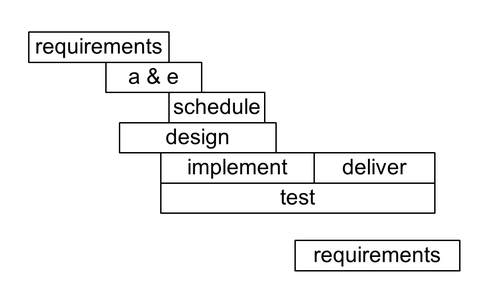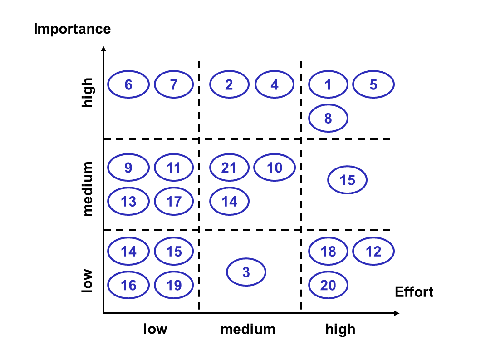Sturdy Development
Overview
Teaching: 5 min
Exercises: 10 minQuestions
What other kind of development process could my project use?
Objectives
Explain the key features of sturdy development.
Explain why sturdy development is a good fit for many mature research software projects.
- Sturdy development is a made-up term to describe “classic” software engineering practices
- Didn’t need a name until agile came along
- Best suited for situations in which:
- Stakeholders insist that developers make commitments to long-term goals (typical of grant cycles)
- Work is so large that division of labor is essential
- Key assumption: measure twice, cut once
- The later a problem is caught, the more expensive it is to fix
- So careful up-front planning can pay for itself by reducing effort downstream
- Truest when the problem domain, good solution strategies, and technologies are all well understood

- Gather requirements: figure out what the software is supposed to do
- The responsibiliyt of the product manager
- While developers are working on version 4, she talks to stakeholders about what they want in version 5
- Never ask them what features they want in the software, but rather:
- What does it do now that you don’t like?
- What can’t you do that you’d like to be able to?
- Product manager collates these needs and figures out how the software should be changed to satisfy them
- *Analysis and estimation</em>: figure out how long features will take to implement
- Each team member is responsible for analyzing and estimating one or more features
- Must come up with a plausible rough design, and estimate how long it will take to implement
- Where possible, come up with two such plans:
- One for the whole feature
- One for a useful subset requiring less effort
- A&E presupposes an overall architecture for the system has already been defined
- Doesn’t make sense to say, “We’ll create a plugin to handle that” unless there’s a plugin system
- Prioritization: because there’s always more to do than there is time to do it
- Create a 3x3 grid whose axes are “effort” and “importance”
- Effort should be “an hour”, “a day”, “a week”
- Anything longer than a week should be broken into sub-tasks
- Importance is “low”, “medium”, “high”
- Effort should be “an hour”, “a day”, “a week”
- Each feature goes into one square
- Then draw a diagonal and throw away everything below it that requires a lot of effort but isn’t important
- Create a 3x3 grid whose axes are “effort” and “importance”

- Create a schedule
- Who is going to do what, when?
- Do not shave estimates to make things fit
- Undermines trust on both sides and leads to “science fiction scheduling”
- Schedule is owned by the project manager, whose job it is to decide when to abandon or reschedule work and what to do instead
- E.g., if a high priority item is taking longer than expected, should it be put on hold and work started on something with lower priority requiring less effort?
- The earlier you let stakeholders know that things are going to be late (or aren’t going to get done at all), the less unhappy they’ll be
- Note: estimation improves with practice
- Do the work
- In practice, some work starts during A&E, since people need to prototype to see if their designs are plausible
- Testing and documentation start at the same time as coding
- Or even earlier: A&E should include estimates for time required to test and explain
- Also start deploying at the same time as development
- Needed for testing
- And need to test packaging and deployment along with everything else
- Stop adding features about 2/3 of the way through the allotted time
- Experience shows that teams need at least 1/3 of the overall cycle to fix bugs and tidy up
- Sturdy development relies on having good requirements
- As unambiguous as a legal contract or a theorem proof
- I.e., two well-informed practitioners should reach the same conclusions about correctness
- “The system will reformat data files as they are submitted” isn’t enough—should have:
- Only users who have logged in by providing a valid user name and password can upload files.
- The system allows users to upload files via a secure web form.
- The system accepts files up to 16MB long.
- The system accepts files in PDB and RJCS-1 format.
- The system converts files to RJCS-2 format before storing them.
- The system displays an error message page if an uploaded file cannot be parsed, but takes no other action.
- Etc.
- Best to specify requirements as tests, but those can still require human-readable explanation
Prioritize
- Draw a 3x3 grid of the kind described above.
- Pick 3-4 open issues for your current project.
- Decide where each one belongs on the grid. Are any of them so large that they should be broken down into sub-tasks?
Write Requirements
- Write an unambiguous specification of a feature you would like to add to your current project.
- Swap specifications with your partner.
- What is the least helpful (or most damaging) implementation of your partner’s feature you can think of that would technically satisfy the specification they wrote?
Key Points
Sturdy development is a software development process based on planning suitable for larger teams and more mature projects.
Key features are division of labor, effort estimation, and long-term scheduling.
Sturdy development is most suitable for large projects with well-defined goals.